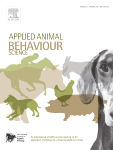Document type: online pre-publication of scientific article in Applied Animal Behaviour Science
Authors: Alice Ruet, Cécile Arnould, Justine Levray, Julie Lemarchand, Núria Mach, Marie-Pierre Moisan, Aline Foury, Christine Briant, Léa Lansade
Résumé en français (traduction) : Les chevaux domestiques vivent principalement dans des boxes individuels, un système d’hébergement considéré comme portant atteinte au bien-être des animaux. Une pratique courante dans les écoles d’équitation consiste à offrir une période temporaire de pâturage avec des congénères pour atténuer l’impact de la privation à long terme déclenchée par les boxes. L’objectif de cette étude était d’évaluer l’influence de cette pratique en utilisant quatre indicateurs comportementaux reflétant un état de bien-être altéré : les stéréotypies, les comportements agressifs envers les humains, la « posture de retrait » reflétant une insensibilité à l’environnement et la « posture d’alerte » indiquant une hypervigilance. Un groupe de 31 chevaux a été suivi avant, pendant et après une période de 1,5 mois au pâturage (comparaisons intra-groupe) et leurs comportements ont été comparés à ceux de 29 chevaux gardés dans des boxes individuels pendant l’étude (comparaisons inter-groupe). Dans les pâturages, aucune stéréotypie et aucun comportement agressif envers les humains n’ont été observés, et la fréquence de la « posture d’alerte » a diminué, bien que les résultats ne soient pas significatifs. Une augmentation de l’expression des comportements naturels tels que la locomotion, l’exploration et les comportements sociaux a été observée. Cependant, l’expression de la « posture de retrait » a augmenté pendant les cinq premiers jours de pâturage (Friedman : P < 0,001 ; Wilcoxon classé : P < 0,001) avant qu’une diminution ne soit observée après 20 jours, revenant au niveau précédemment observé lorsque les chevaux étaient au box (Wilcoxon classé : P < 0,01). Ces résultats suggèrent que le fait d’aller au pâturage peut influencer positivement l’état de bien-être des chevaux, mais aussi que plusieurs jours d’adaptation sont nécessaires, probablement en raison de la nouveauté des conditions environnementales et sociales. Le résultat le plus notable s’est produit lorsque les chevaux sont retournés dans des boxes individuels. Une forte augmentation de la fréquence des stéréotypies (test de Cochran : P < 0,001 ; Chi² d’homogénéité : P = 0,05), du » retrait » (Friedman : P < 0,001 ; Wilcoxon rank-sum : P < 0,05) et des postures » d’alerte » (Friedman : P < 0,01 ; Wilcoxon rank-sum : P < 0,001) a été observée au cours des cinq premiers jours de retour au box. L’expression de la majorité des comportements naturels est immédiatement revenue au niveau observé pendant la période précédant le pâturage. Après trois mois, l’expression des quatre indicateurs de bien-être n’était pas différente de celle de la période précédant le pâturage. Ces résultats démontrent que les effets bénéfiques susceptibles d’être induits par le pâturage ne durent pas lorsque les chevaux retournent dans les boxes individuels et que le changement environnemental entraîne des effets délétères à court terme sur l’état de bien-être des animaux. Il serait donc recommandé de maintenir les chevaux domestiques en permanence au pâturage lorsque cela est possible.
Résumé en anglais (original) : Domesticated horses mainly live in individual boxes, a housing system reported as compromising animal welfare. A common practice in riding schools involves offering a temporary period on pasture with conspecifics to alleviate the impact of long-term deprivation triggered by boxes. The aim of this study was to assess the influence of this practice using four behavioural indicators reflecting a compromised welfare state: stereotypies; aggressive behaviours towards humans; the “withdrawn posture” reflecting unresponsiveness to the environment; and the “alert posture” indicating hypervigilance. A group of 31 horses was monitored before, during and after a period of 1.5 months on pasture (intra-group comparisons) and their behaviours were compared to those of 29 horses kept in individual boxes during the study (inter-group comparisons). On pasture, no stereotypies and aggressive behaviours towards humans were observed, and the occurrence of the “alert posture” decreased, although the results were not significant. An increase in the expression of natural behaviours such as locomotion, exploration and social behaviours was observed. However, the expression of the “withdrawn posture” increased during the first five days on pasture (Friedman: P < 0.001; Wilcoxon signed-rank: P < 0.001) before a decrease was observed after 20 days, returning to the level previously observed when horses were in boxes (Wilcoxon signed-rank: P < 0.01). These results suggest that going out to pasture can positively influence the welfare state of horses, but also that several days of adaptation are needed, probably due to the novelty of the environmental and social conditions. The most noticeable result occurred when horses returned to individual boxes. A sharp increase in the occurrence of stereotypies (Cochran test: P < 0.001; Chi² of homogeneity: P = 0.05), of the “withdrawn” (Friedman: P < 0.001; Wilcoxon rank-sum: P < 0.05) and the “alert” postures (Friedman: P < 0.01; Wilcoxon rank-sum: P < 0.001) was observed during the first five days of returning to confinement. The expression of the majority of natural behaviours immediately returned to the level observed during the pre-pasture period. After three months, the expression of the four welfare indicators was not different from that in the pre-pasture period. These results demonstrate that the beneficial effects likely to be induced by the pasture do not last when horses return to individual boxes and that the environmental change causes deleterious short-term effects on the animals’ welfare state. It would thus be recommended to keep domestic horses permanently on pasture when possible.






